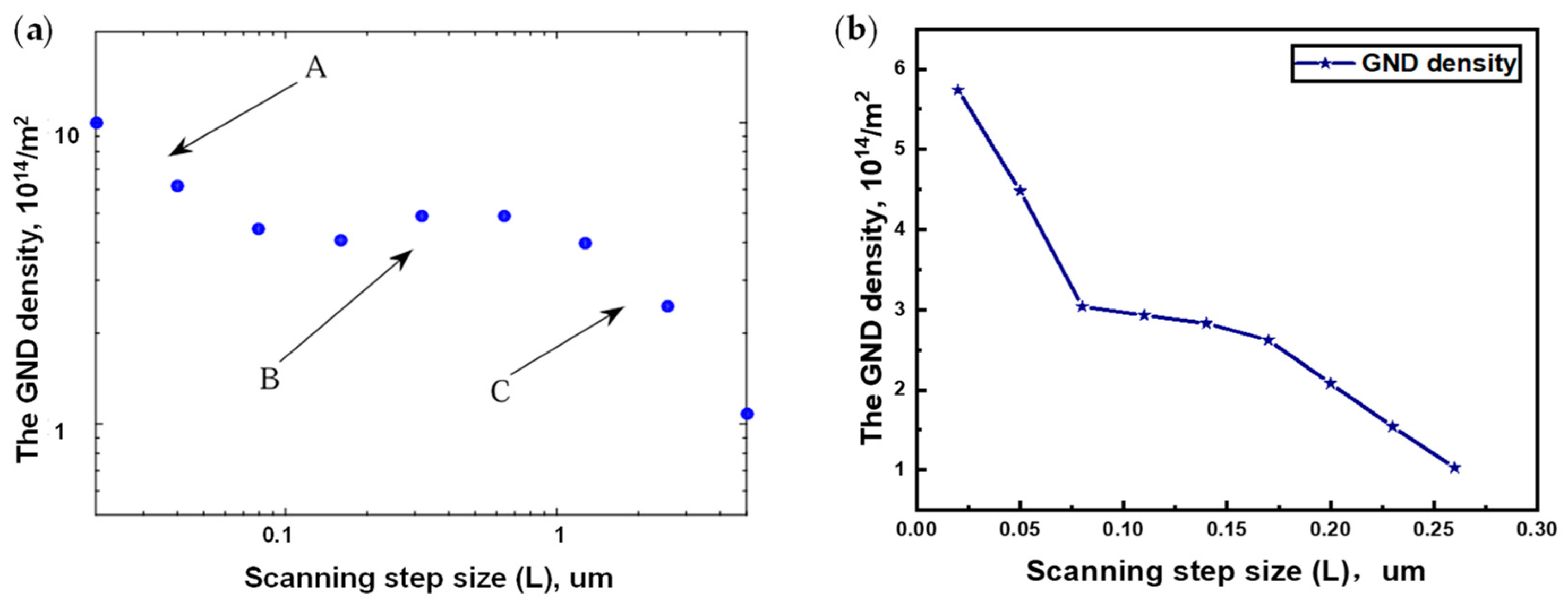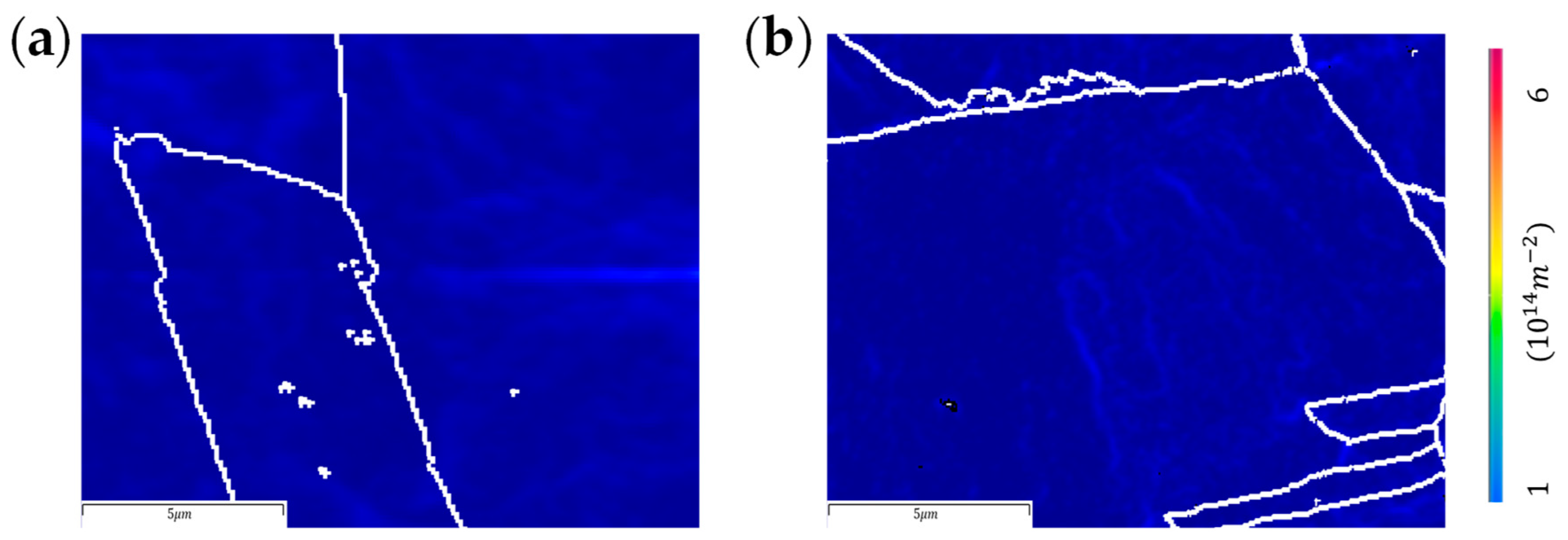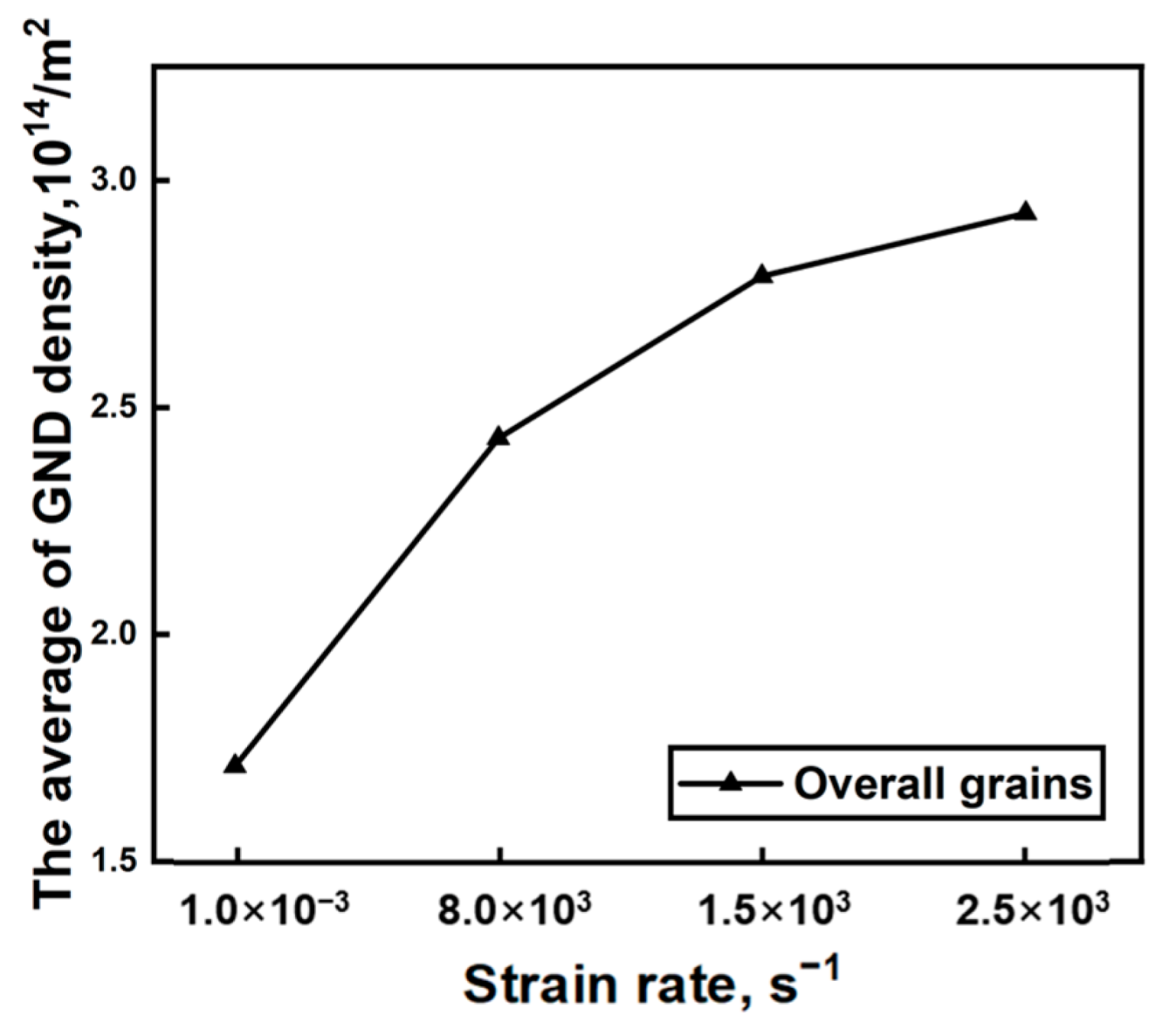Effects of Strain Rate on the GND Characteristics of Deformed Polycrystalline Pure Copper
Abstract
:1. Introduction
2. Materials and Experimental Methods
2.1. Materials
2.2. Experimental Methods
2.3. EBSD Observation of GNDs
3. Experimental Results
3.1. Evolution of Global GND Characteristics with Strain Rate
3.2. Evolution of Local GND Characteristics with Strain Rate
4. Analysis and Discussion
4.1. Influence of Intragranular Dislocation Cell Behaviors on GND Characteristics
4.2. Influence of Dislocation Cells and Misorientations on GND Characteristics near the Grain Boundaries
4.3. Effect of Grain Refinement on GND Density
5. Conclusions
Author Contributions
Funding
Data Availability Statement
Conflicts of Interest
References
- Ashby, M.F. The deformation of plastically non-homogeneous materials. Philos. Mag. A J. Theor. Exp. Appl. Phys. 2006, 21, 399–424. [Google Scholar] [CrossRef]
- Fleck, N.A.; Ashby, M.F.; Hutchinson, J.W. The role of geometrically necessary dislocations in giving material strengthening. Scr. Mater. 2003, 48, 179–183. [Google Scholar] [CrossRef]
- Gao, H.; Huang, Y. Geometrically necessary dislocation and size-dependent plasticity. Scr. Mater. 2003, 48, 113–118. [Google Scholar] [CrossRef]
- Mughrabi, H. Dislocation wall and cell structures and long-range internal stresses in deformed metal crystald. Acta Metall. 1983, 31, 1367–1379. [Google Scholar] [CrossRef]
- Hughes, D.A.; Hansen, N. Microstructure and strength of nickel at large strains. Acta Mater. 2000, 48, 2985–3004. [Google Scholar] [CrossRef]
- Taylor, G.I. The Mechanism of Plastic Deformation of Crystals. Part I. Theoretical Plastic Deformation of Crtstals. Proc. R. Soc. Lond. 1934, 145, 362–387. [Google Scholar]
- Kuhlmann-Wilsdorf, D.; Laird, C. Dislocation behavior in fatigue II. Friction stress and back stress as inferred from an analysis of hysteresis loops. Mater. Sci. Eng. A 1979, 37, 111–120. [Google Scholar] [CrossRef]
- Jang, M.J.; Praveen, S.; Sung, H.J.; Bae, J.W. High-temperature tensile deformation behavior of hot rolled CrMnFeCoNi high-entropy alloy. J. Alloys Compd. 2018, 730, 242–248. [Google Scholar] [CrossRef]
- Han, Q.; Lei, X. Effects of temperature and load on fretting fatigue induced geometrically necessary dislocation distribution in titanium alloy. Mater. Sci. Eng. A 2021, 800, 140308. [Google Scholar] [CrossRef]
- Zheng, J.; Pruncu, C. Quantifying geometrically necessary dislocation density during hot deformation in AA6082 Al alloy. Mater. Sci. Eng. A 2021, 814, 141158. [Google Scholar] [CrossRef]
- Zhang, J.; Wang, B.; Wang, H. Geometrically necessary dislocations distribution in face-centerd cubic alloy with varied grain size. Mater. Charact. 2020, 162, 110205. [Google Scholar] [CrossRef]
- Despax, L.; Vidal, V.; Delagnes, D. Influence of strain rate and temperature on the deformation mechanisms of a fine-grained Ti-6Al-4V alloy. Mater. Sci. Eng. A 2020, 790, 139718. [Google Scholar] [CrossRef]
- Jena, P.S.M.; Pradham, S.K. Evolution of geometrically necessary dislocation at the γ-γ′ interface and its effect on tensile deformation behaviour of disk super alloy. Mater. Sci. Eng. A 2021, 807, 140855. [Google Scholar] [CrossRef]
- Gao, W.; Liu, J.; Zhou, J. Effect of grain size on deformation and fracture of Inconel718: An in-situ SEM-EBSD-DIC investigation. Mater. Sci. Eng. A 2022, 961, 144362. [Google Scholar] [CrossRef]
- Gallet, J.; Perez, M.; Guillou, R. Experimental measurement of dislocation density in metallic materials: A quantitative comparison between measurements techniques (XRD, R-ECCI, HR-EBSD, TEM). Mater. Charact. 2023, 199, 112842. [Google Scholar] [CrossRef]
- Jiang, J.; Britton, T.B. The orientation and strain dependence of dislocation structure evolution in monotonically deformed polycrystalline copper. Int. J. Plast. 2015, 69, 102–117. [Google Scholar] [CrossRef]
- Kundu, A. Geometrically Necessary Dislocation Density Evolution in Interstitial Free Steel at Small Plastic Strains. Metall. Mater. Trans. A 2018, 49A, 3274–3281. [Google Scholar] [CrossRef]
- Liu, M.; Liu, Y.; Li, H. Deformation mechanism of ferrite in a low carbon Al-killed steel: Slip behavior, grain boundary evolution and GND development. Mater. Sci. Eng. A 2022, 842, 143093. [Google Scholar] [CrossRef]
- Zhang, S.; Romo, S.; Giorjao, R.A.; Leao, P.B.P.; Ramirez, A.J. EBSD analysis of strain distribution and evolution in ferritic-Pearlitic steel under cyclic deformation at intermediate temperature. Mater. Charact. 2022, 193, 112293. [Google Scholar] [CrossRef]
- Pai, N.; Prakash, A.; Samajdar, I.; Patra, A. Study of grain boundary orientation gradients through combined experiments and strain gradient crystal plasticity modeling. Int. J. Plast. 2022, 156, 103360. [Google Scholar] [CrossRef]
- Li, J.; Wu, X.; Liao, B. Simulation of dynamic recrystallization in an Al-Mg-Si alloy during inhomogeneous hot deformation. Mater. Today Commun. 2021, 29, 102810. [Google Scholar] [CrossRef]
- Li, Z.; Ge, J.; Kong, B. Strain Rate Dependence and Recrystallization Modeling for TC18 Alloy during Post-Deformation Annealing. Materials 2023, 16, 1140. [Google Scholar] [CrossRef] [PubMed]
- Shaarbaf, M.; Toroghinegad, M.R. Influence of high strain rate deformation on the microstructure and mechanical behavior of NiCoCrFe high entropy alloy. J. Mater. Res. Technol. 2023, 27, 2264–2279. [Google Scholar] [CrossRef]
- Cheng, J.; Xu, C.; Zhang, T. Microstructure and dynamic mechanical behavior of wire-arc additive manufactured high-strength steel. J. Mater. Res. Technol. 2023, 25, 6099–6110. [Google Scholar] [CrossRef]
- Liu, Q.; Fang, L.; Xiong, Z. The response of dislocations, low angle grain boundaries and high angle grain boundaries at high strain rates. Mater. Sci. Eng. A 2021, 822, 141704. [Google Scholar] [CrossRef]
- Jiang, J.; Britton, T.B. Accumulation of geometrically necessary dislocations near grain boundaries in deformed copper. Philos. Mag. Lett. 2012, 92, 580–588. [Google Scholar] [CrossRef]
- Kundu, A.; Field, D.; Chakraborti, P.C. Effect of strain and strain rate on the development of deformation heterogeneity during tensile deformation of a solution annealed 304 LN austenitic stainless steel: An EBSD study. Mater. Sci. Eng. A 2020, 733, 138854. [Google Scholar] [CrossRef]
- Sadeghi, B.; Qi, J.; Min, X. Modelling of strain rate dependent dislocation behavior of CNT/Al composites based on grain interior/grain boundary affected zone (GI/GBAZ). Mater. Sci. Eng. A 2021, 820, 141547. [Google Scholar] [CrossRef]
- Tang, W.; Liu, S.; Liu, Z. Microstructure evolution and constitutive relation establishment of Mg–7Gd–5Y–1.2Nd–0.5Zr alloy under high strain rate after severe multi-directional deformation. Mater. Sci. Eng. A 2021, 809, 140994. [Google Scholar] [CrossRef]
- Ye, C.; Chen, R.; Liu, G. Crystal Plasticity Finite Element Simulation of Polycrystal Aluminum under Shock Loading. Chin. J. High Press. Phys. 2022, 36, 064203. [Google Scholar]
- Tian, Z.; Zhang, T.; Wang, Z. Dynamic tensile deformation of Al0.1Ti0.1CoCrFeNi high entropy alloy with heterogeneous grain structure. J. Alloys Compd. 2023, 968, 172092. [Google Scholar] [CrossRef]
- Kundu, A.; Field, D.P. Influence of microstructural heterogeneity and plastic strain on geometrically necessary dislocation structure evolution in single-phase and two-phase alloys. Mater. Charact. 2020, 170, 110690. [Google Scholar] [CrossRef]
- Voisin, T.; Grapes, M.D.; Santala, M.K. In situ TEM observations of high-strain-rate deformation and fracture in pure copper. Mater. Today 2020, 33, 10–16. [Google Scholar] [CrossRef]
- Jiang, J.; Britton, T.B.; Wilkinson, A.J. Evolution of dislocation density distributions in copper during tensile deformation. Acta Mater. 2013, 61, 7227–7239. [Google Scholar] [CrossRef]
- Lu, F. Hopkinson Bar Experimental Technique; Science Press: Beijing, China, 2013. [Google Scholar]
- Wang, L. Stress Wave Foundation; National Defense Industry Press: Beijing, China, 2005. [Google Scholar]
- Chen, W.W.; Song, B. Split Hopkinson Bar: Design, Testing and Applications; Springer: New York, NY, USA, 2011. [Google Scholar]
- Ma, D.; Chen, D.; Wu, S. An interrupted tensile testing at high strain rates for pure copper bars. J. Appl. Phys. 2010, 108, 114902. [Google Scholar]
- Wang, C.; Wang, C.; Sun, C. Strain rate effects on mechanical behavior and microstructure evolution with the sequential strains of TWIP steel. Mater. Sci. Eng. A 2022, 835, 142673. [Google Scholar] [CrossRef]
- Slycken, J.V. Advanced Use of a Split Hopkinson Bar Setup Application to TRIP Steels. Ph.D. Thesis, Universient Gent, Gent, Belgium, 2008. [Google Scholar]
- Jiang, J.; Britton, T.B.; Wilkinson, A.J. Measurement of geometrically necessary dislocation density with high resolution electron backscatter diffraction: Effects of detector binning and step size. Ultramicroscopy 2013, 125, 1–9. [Google Scholar] [CrossRef] [PubMed]
- Wilkinson, A.J.; Randman, D. Determination of elastic strain fields and geometrically necessary dislocation distributions near nanoindents using electron back scatter diffraction. Philos. Mag. 2009, 90, 1159–1177. [Google Scholar] [CrossRef]
- Ruggles, T.J.; Rampton, T.M.; Khosravani, A. The effect of length scale on the determination of geometrically necessary dislocations EBSD continuum dislocation microscopy. Ultramicroscopy 2016, 164, 1–10. [Google Scholar] [CrossRef]
- Dai, J.; Min, X.; Wang, L. Dynamic response and adiabatic shear behavior of β-type Ti-Mo alloys with different deformation modes. Mater. Sci. Eng. A 2022, 857, 144108. [Google Scholar] [CrossRef]
- Zheng, Y.; Zheng, W.; Wang, Y. High strain rate compression behavior of a heavily stabilized beta titanium alloy: Kink deformation and adiabatic shearing. J. Alloys Compd. 2017, 708, 84–92. [Google Scholar] [CrossRef]
- Gray, G.T., III. High Strain rate deformation: Mechanical behavior and deformation substructures induced. Annu. Rev. Mater. Sci. 2012, 42, 285–303. [Google Scholar] [CrossRef]
- Chang, Y.J.; Shume, A.J.; Bassim, M.N. A note on dislocation-cell structures in commercial copper. Mater. Sci. Eng. A 1988, A103, L1–L4. [Google Scholar] [CrossRef]
- Meyer, M.A.; Gregori, F.; Kad, B.K. Laser-induced shock compression of monocrystalline copper: Characterization and analysis. Acta Meterialia 2003, 51, 1211–1228. [Google Scholar] [CrossRef]
- Gottstein, G.; Molodov, D.A.; Shvindlerman, L.S. Grain boundary migration: Misorientation dependence. Curr. Opin. Solid State Mater. Sci. 2001, 5, 9–14. [Google Scholar] [CrossRef]
- Gottschalk, D.; McBride, A.; Reddy, B.D. Computational and theoretical aspects of a grain-boundary model that accounts for grain misorientation and grain-boundary orientation. Comput. Mater. Sci. 2016, 111, 443–459. [Google Scholar] [CrossRef]
- Lim, H.; Lee, M.G.; Kim, J.H. Simulation of polycrystal deformation with grain and grain boundary effects. Int. J. Plast. 2011, 27, 1328–1354. [Google Scholar] [CrossRef]
- Liu, W.; Liu, Y.; Sui, H. Dislocation-grain boundary interaction in metallic materials: Competition between dislocation transmission and dislocation source activation. J. Mech. Phys. Solids 2020, 20, 30391–30394. [Google Scholar] [CrossRef]
- Pan, H.; He, Y.; Zhang, X. Interactions between Dislocations and Boundaries during Deformation. Materials 2021, 14, 1012–1047. [Google Scholar] [CrossRef]
- Bollmann, W. Crystal Lattices, Interfaces, Matrices: An Extension of Crystallography; W. Bollmann: Geneva, Switzerland, 1983. [Google Scholar]
- Rui, S.; Niu, L.; Shi, H. Diffraction-based misorientation mapping: A continuum mechanics description. J. Mech. Phys. Solids 2019, 133, 103709. [Google Scholar] [CrossRef]
- Hansen, B.L.; Beyerlein, I.J.; Bronkhorst, C.A. A dislocation-based multi-rate single crystal plasticity model. Int. J. Plast. 2013, 44, 129–146. [Google Scholar] [CrossRef]
- Shahba, A.; Ghosh, S. Crystal plasticity FE modeling of Ti alloys for a range of strain-rates. Part I: A unified constitutive model and flow rul. Int. J. Plast. 2016, 87, 48–68. [Google Scholar] [CrossRef]
- Zhang, S.; Liu, W.; Wan, J. The grain size and orientation dependence of geometrically necessary dislocations in polycrystalline aluminum. Mater. Sci. Eng. A 2020, 775, 138939. [Google Scholar] [CrossRef]














Disclaimer/Publisher’s Note: The statements, opinions and data contained in all publications are solely those of the individual author(s) and contributor(s) and not of MDPI and/or the editor(s). MDPI and/or the editor(s) disclaim responsibility for any injury to people or property resulting from any ideas, methods, instructions or products referred to in the content. |
© 2024 by the authors. Licensee MDPI, Basel, Switzerland. This article is an open access article distributed under the terms and conditions of the Creative Commons Attribution (CC BY) license (https://creativecommons.org/licenses/by/4.0/).
Share and Cite
Ma, Y.; Liu, G.; Yang, S.; Chen, R.; Xu, S.; Shen, Y. Effects of Strain Rate on the GND Characteristics of Deformed Polycrystalline Pure Copper. Metals 2024, 14, 582. https://doi.org/10.3390/met14050582
Ma Y, Liu G, Yang S, Chen R, Xu S, Shen Y. Effects of Strain Rate on the GND Characteristics of Deformed Polycrystalline Pure Copper. Metals. 2024; 14(5):582. https://doi.org/10.3390/met14050582
Chicago/Turabian StyleMa, Yidan, Guisen Liu, Shuqing Yang, Ran Chen, Shuopeng Xu, and Yao Shen. 2024. "Effects of Strain Rate on the GND Characteristics of Deformed Polycrystalline Pure Copper" Metals 14, no. 5: 582. https://doi.org/10.3390/met14050582



